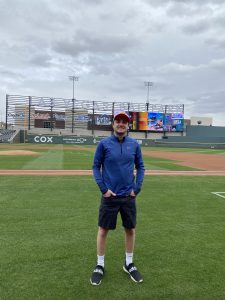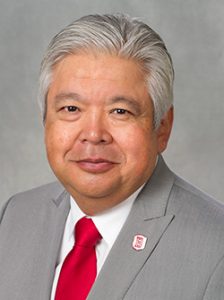Amidst the COVID-19 pandemic, it wasn’t just students who had to adjust to the online world of Zoom University; faculty had to as well.
During the extended spring break last semester, faculty partook in a Sakai training session. The change was unexpected for some and demanded a flexible work process.
Even if they had a preferred style of teaching, faculty have to still prepare for an online switch after Thanksgiving break. The provost office was asked for a comment but did not respond.
Classes are now taught through multiple methods such as asynchronous, online lectures, hybrid-style and in-person.
“Just being back in the class was wonderful,” Josh Dickhaus, associate professor of sports communications, said. “I’m meant to be a college professor, but I am meant to be a college professor who is teaching in a classroom.”
Some classes moved buildings entirely, as the university evaluated spaces better equipped for social distancing being enforced. Before the two-week quarantine was implemented, Dickhaus was previously teaching two classes in the Michel Student Center’s Marty Theater. In those classes, everyone was required to social distance. He said he’s hoping that quarantine is effective so he can return to in-person teaching.
Others never saw a physical classroom this semester, as they’ve posted course material online for remote learning.
“I decided to teach the classes that I could asynchronously because last semester, I had students who got sick/cared for sick family members/had to pick up new work shifts and so they would not have been able to continue with the class had it been synchronous,” Priscilla Charat-Nelson, a world language professor, said in an email interview.
Nelson said she prefers to work in-person and with her classroom all at once, but she didn’t think it would be possible for students to make it to classes all the time due to jobs or personal issues. While there isn’t a sense of community that she prefers, she said that it’s accommodating for everyone in her class.
Meanwhile, as course styles are changing drastically, faculty are emphasizing their students to take care of themselves this semester. Classes have been prepared for an early online switch if needed.
“Even though I have been fully online and we can continue that way without any problems, [with] the fact that my students are going through this, and I need to make sure that they are doing okay,” Travis Stern, associate professor of theater arts, said. “My class may not have changed, but their lives have changed.”
Some instructors said that their class Zoom sessions may be cut short to keep students’ attention, made asynchronously or will be much more available for discussion with students. Keeping focus is also a priority.
“Finding a space in your apartment or your dorm room that is unusual for you to be in and doing your studying there works as well,” Stern said. “I have told students to go sit in the corner like they are in timeout.”
While it may seem like self-punishment, Stern said the idea is to designate a space for studying and work keeps students in a concentrated mindset.
Classes during the pandemic have required professors to become flexible. All of this is to ensure that students are still getting their education despite the uncertainties of the fall semester.




